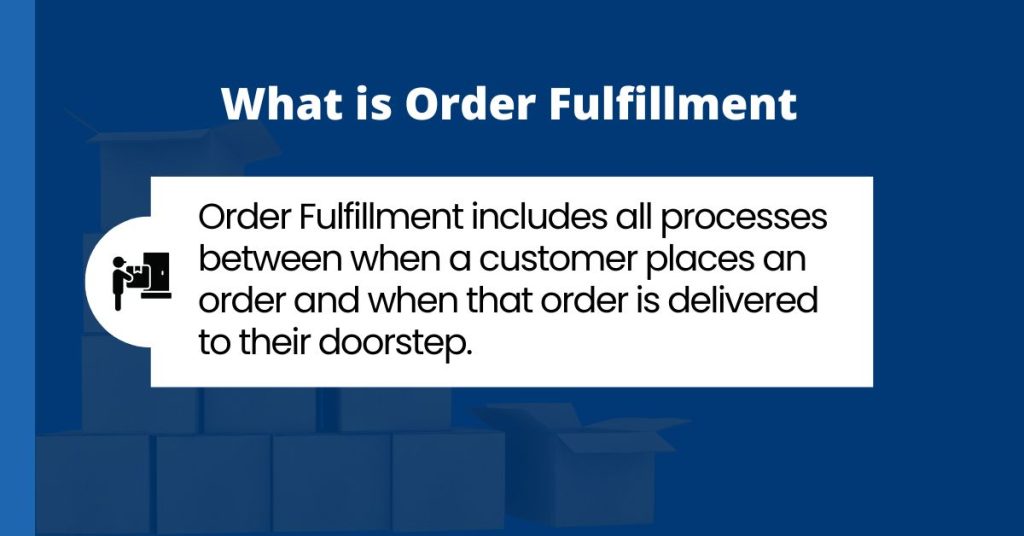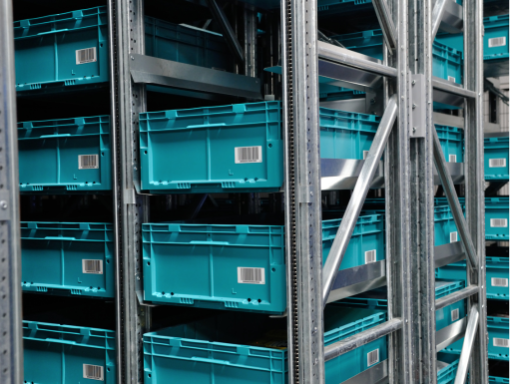Whether you handle your order fulfillment in-house or you outsource it to a third-party logistics company (3PL), it is crucial to have a fundamental understanding of what it is and some ways that you can improve your process.
What is Order Fulfillment?
Order Fulfillment includes all processes between when a customer places an order and when that order is delivered to their doorstep.
This can include shipping the order to the customer, assembling the products, or providing customer service. In the supply chain, order fulfillment is often one of the final steps before the product reaches the consumer.

Strategies to Improve the Order Fulfillment Process at Each Stage
Optimization can occur by analyzing the key processes that make up Order Fulfillment and identifying ways to improve each process.
1. Receiving The Order
Ensure that the most efficient and accurate method of taking the customer’s order is utilized. Whether in-person, by phone, or through an online process. Are the methods employed ensuring the accurate entry of this order? Can all necessary information for the order be captured for processing?
2. Processing The Order
Once a customer’s order is received and entered, it needs to be processed, checked against inventory, and added to a picking queue. By utilizing Warehouse Management Software (WMS) companies can ensure accurate inventory stock levels, automate order processing, and evaluate optimum picking and packing strategy. The ability to generate pick lists and confirm those picks and remove items from inventory are often benefits of using a WMS.
3. Picking The Order
Determine the best picking procedure for your product mix – single order, batch, and wave, or zone picking. Utilization of system automation and a WMS can also improve picking accuracy and productivity. Ensure that your Distribution Center is organized to efficiently pick orders by establishing storage methods that allow for the least amount of product movement and determine the best method for that movement. Conveyor systems, pick carts, and robots are standard strategies used to move products efficiently.
4. Packing The Order
Evaluate the options for packing the completed order for shipping. Explore and implement processes, such as advanced cartonization, to incorporate packing into the picking process. Determine whether automation solutions are warranted and consider if consolidating packing types and/or sizes will improve logistical or financial operations.
5. Shipping The Order
Optimize shipping by structuring process rules according to defined product categories. Utilize the same rules to identify the best carriers to ensure timely delivery. Automate decisions by using WMS to analyze product package size, weight, and length of time to complete the shipping process.
By following these recommendations, there is a greater likelihood of realizing shipping cost reductions while improving delivery time.
6. Plan For Returns
Improve customer service by streamlining return processes. The use of WMS in processing returns allows customers to acquire return labels, track the product and automate their refund. WMS can also aid in re-introducing the item into inventory and managing defective products.
7. Implement One Touch Fulfillment
One Touch Fulfillment offers the attractive option of having only one person handle or touch the order throughout the entire process from order receipt, picking, packing, and shipping.
Select Box or Container First
By leveraging a WMS, an operation can use cartonization to analyze the dimensions of each item that is to be picked.
By knowing these dimensions, the software will take each item into consideration and then select the right box(s) available that the order will fit into. By selecting the box before the pick, there is no wasted shipping space in the box, and shipping rates and shipping costs will be reduced as you are using the correct box and not paying for empty space.
Rate Shopping
With the WMS working hand in hand with a TMS, the WMS has already selected the correct box, then the TMS can rate shop LTL and Parcel carriers like UPS, FEDEX and USPS to find the most inexpensive shipping rate that meets all the customer, vendor, and carrier requirements.
This keeps shipping costs as low as possible sending the right package with the right carrier.
Print and Apply Shipping Labels
Two of the biggest tasks in a warehouse operation have been completed before the picker has even taken one step. Now, the picker prints the shipping label, applies it to the selected box, and sets the boxes on a box-picking cart. They can put as many orders on the cart as possible and leave the area, now able to pick all the orders on the cart at the same time.
Pick to Box
The WMS guides the picker (through RF devices) to designated areas, in a designated order, on a specific path that will maximize picking time and steps taken. The pick is accomplished by fulfilling multiple orders on only one trip through each area.
Sealed and Ready for Shipping
After picking the order, all that is left is for the orders to be sealed. This operation can be performed by the picker, but many operations employ an auto sealer with a barcode scanner that can read the barcode, verify the order is ready to be shipped, and readied to leave the warehouse.

How to Evaluate your Order Fulfillment Process
When evaluating Order Fulfillment focus on these three steps to make the best decision.
1. Optimize Workflows
You want to minimize the number of times that a human must interact with a product to satisfy the order fulfillment. Eliminating unnecessary “touches” will reduce the time an employee spends picking and packing the order. This creates greater productivity with a reduction in Labor costs.
2. Focus on The Things You Can Change
Consider simplifying the number of steps in each order fulfillment process. Evaluate if there are simple changes that can be implemented right away to improve order fulfillment. Rearranging your warehouse allows for fewer workers to complete the same tasks. Look to an order management software system to enhance order visibility, reduce time-on-task and address labor costs.
3. Prioritize Optimization of High-Volume Items
Design inventory storage to maximize order fulfillment. First, sort items by picking type (pallet, case, or piece). Next, slot inventory according to how quickly they sell. Most companies see 80% of sales from 20% of items. By implementing ways to streamline order processing of the top 20% of your items, you have a higher potential to improve efficiency and achieve benefits from the workflow.
As you consider order fulfillment optimization, keep in mind these key factors to help ensure the most efficient and accurate process is established and will bring the best results in customer satisfaction.
How do you improve order fulfillment accuracy?
Utilizing warehouse picking software improves order fulfillment accuracy by enabling the following processes:
Barcode Scanning
Order Verification
Inventory Management
Pick Path Optimization
Visual & Audio Cues
Error Prevention Measures
Quality Control Checks
Advanced Picking Methods
What are the six steps in the order fulfillment process?
Receiving, processing, picking orders, packing orders, adjusting inventory and shipping.
Receiving. You receive the order placed by the customer. This is typically through an eCommerce platform or via electronic data interchange (EDI) methods. You notify the customer that their order has been received.
Processing. You process the order in your order fulfillment system or warehouse management system. The ordered items are checked against the inventory and added to the picking queue.
Picking. Your team picks the order.
Packing. The order is packed. You send an advanced shipping notification (ASN) to the customer.
Inventory Adjustment. Your inventory management software should update your inventory counts.
Shipping. You arrange the shipping mode and ship the order. The customer receives the order.
What are the bottlenecks in the order fulfillment process?
Bottlenecks occur most frequently during the picking and packing processes of order fulfillment. Some example bottlenecks are:
Inaccurate inventory counts
Incomplete/problem orders slow down the order-picking process
Inefficient order release or order picking methods that make pickers walk long distances
Time-consuming packing
Why is perfect order fulfillment so critical to successful operations?
Perfect order fulfillment is a crucial KPI that assesses how effectively a company fulfills customer orders. Efficient order fulfillment is an important KPI to measure because it leads to the following:
Customer Satisfaction
Brand Reputation
Repeat Business
Reduced Costs
Efficient Operations
Competitive Advantage
Supply Chain Optimization
Long-Term Growth
Positive Word-of-Mouth
Improved Partner Relationships





